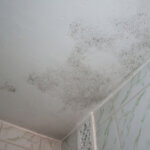Since 1980, flooding from major storms in the United States causes on average an estimated 3.7 billion dollars in damage per year, according to the National Oceanic and Atmospheric Administration.
That price tag precedes a record number of named storms predicted for the United States in 2020. So, it’s no wonder people are concerned about flood damage when storms like Isaias and Bertha bear down on us.
The water damage caused by catastrophic flooding is an emotional and financial killer. But you may be able to spare your hardwood floors — one of the most popular floorings in the U.S — a complete tear-out and replace. Flooding destroys the floor’s finish and causes boards to warp and buckle. Harmful mold can also develop if the water is left to stand.
In the following post, we’ll take a look at five tips to try and rescue your hardwood floors from flood damage.
1. Clear Out After Flood Damage
We flicked at major storms as a cause of flooding above, but there are lots of ways for water to flood your hardwood floors.
Your pipes could burst, a toilet could overflow or a hole in your roof could all-cause excess water to damage your floors. Hardwood floors — compared to tile, or vinyl — are easy to damage. Normal wear and tear over a few years can prompt a homeowner to consider refinishing their wide-plank tiger maple, not to mention 2 inches of standing water after a flood.
The first step in rescuing your hardwood floors is to empty the rooms. Rugs and furniture will only get in the way, reduce drying and constrict airflow (and you’re going to need it).
2. Suck It Up, Buttercup
Standing water needs to go. You can use s standard wet/dry vacuum (aka ShopVac) to get that water up. And when you think you’re done, keep going. You’ll need to keep vacuuming to get water our of the microscopic pores of the wood. If you don’t get this “invisible” moisture out, you could develop problems later and derail your flood damage restoration.
3. Keep It Clean
You’ll need to disinfect your floor with hot-water and an ammonia-free detergent. This will clean any dirt, debris, and help prevent mildew.
4. Dehumidify and Don’t Spare the Fans
You’re going to need to blow harder than a Jennifer Anniston flick to save those hardwood floors. Set up as many fans as you can and keep the airflow moving. Also, get a commercial dehumidifier to clear those aforementioned pores. Run this setup for a least 24 hours.
5. Check Your Work
You’ll want to meter check for water, eyeball the finish, and look for mildew or mold spots before you wrap up. If you get a positive result on the moisture meter, keep dehumidifying. If you see mildew spots, break out the disinfectant for another serious scrub.
If First You Don’t Succeed, Give Up
You gotta face facts: Water and hardwood floors are a bad mix. Even if you scrub and fan-like a sorcerer’s apprentice, you might not get all that moisture up. Sometimes you’ve got to know when you’re beaten and call in the pros.
Hopefully, that’s where we come in. If you need help with flood damage or have questions related to residential or commercial cleaning, please contact us here.




